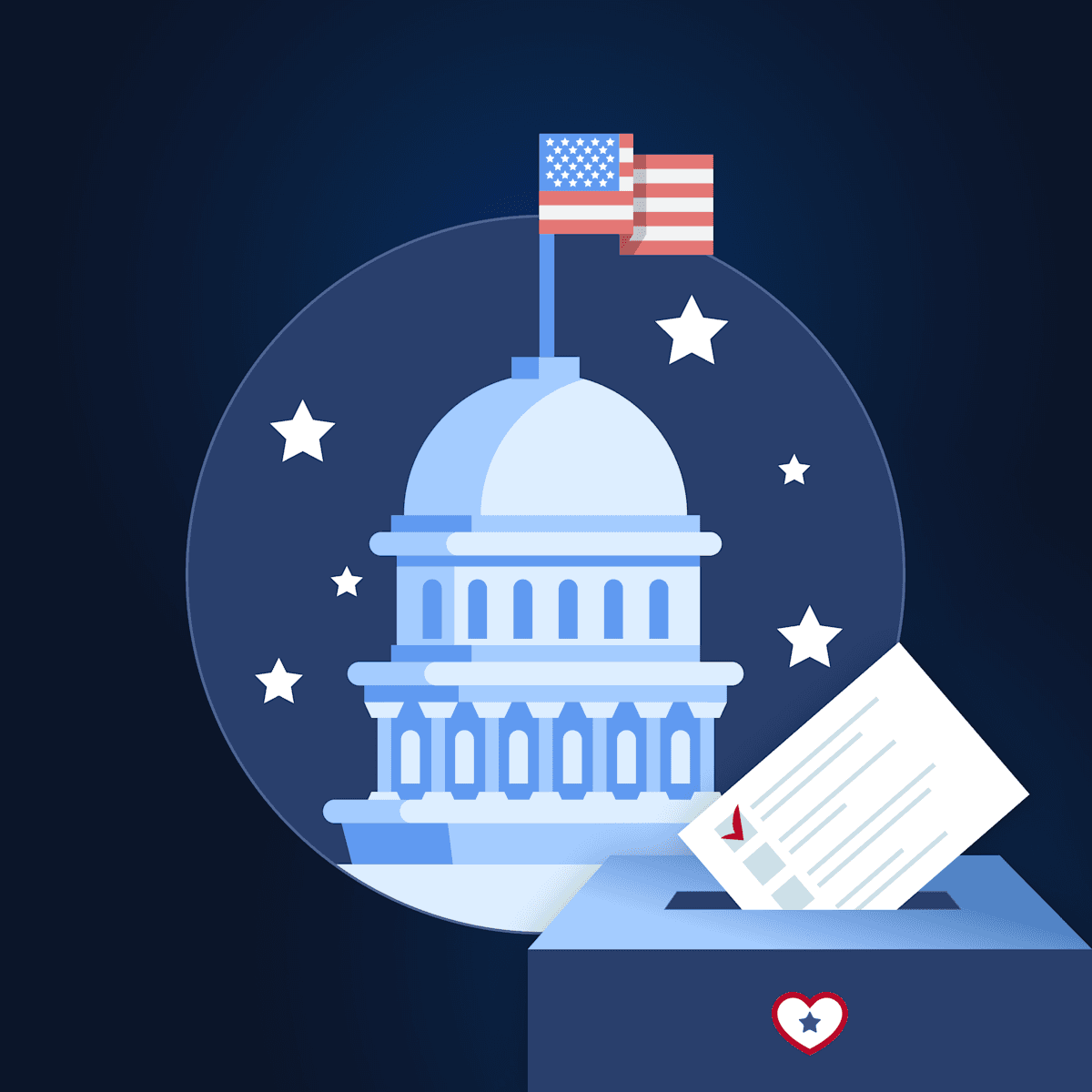
What Is Civic Engagement? Understanding the Power of Active Citizenship
What does it mean to be civically engaged? How can you be a more active citizen, and why does it matter? In this guide, we’ll explore the answers to these questions while providing practical tips for everyday Americans.
Read on to learn more about different types of civic engagement, the impact of active citizenship on our democracy, and recent trends in civic participation.
What Is Civic Engagement?
Civic engagement describes the work we do to make a difference in the lives of our communities. It also encompasses the work we do to deepen the knowledge and skills that help us make an impact.
Civic engagement can be both political and nonpolitical. If you’ve ever voted in an election, attended a school board meeting, or volunteered in your community, you have been civically engaged.
Other examples of civic engagement include:
Contacting your elected officials
Participating in community clean-ups
Learning about how your local government works
Signing petitions
Responding to public opinion surveys
Organizing or attending events such as sit-ins and protests
Donating canned food or gently used clothes to a charitable drive
Canvassing on behalf of a political campaign
Raising awareness for local issues on social media or offline
Submitting a public comment or attending a public hearing
Civic engagement is essential for ensuring all residents have their voices heard and needs met. It can also foster a stronger sense of community and belonging.
Types of Civic Engagement
Many activities can fall under the umbrella of civic engagement, and we can categorize them in multiple ways.
One way is to separate political and nonpolitical activities. Voting in an election, contacting your elected officials, and volunteering for a political campaign are all examples of political civic participation. On the other hand, volunteering for a local nonprofit, participating in a community clean-up, and donating to a charitable drive could all be called nonpolitical.
Another way to break down the types of civic engagement, with examples, is:
Political Engagement: Voting, emailing your representatives, etc.
Political Activism: Protesting, attending a sit-in, etc.
Civic Education: Learning how your local government is structured, attending a citizen’s academy, etc.
Community Service: Volunteering for your local animal shelter, assisting in community clean-ups, etc.
Philanthropy: Donating to a community organization, donating to a public university, etc.
Different people choose to engage with their local and national political processes in different ways. What matters is finding what works for you. However you participate, strong civic engagement can make a real impact while also benefiting and empowering you.
LEARN MORE: Ready to make your mark? Explore eight easy ways to get involved in local politics.
Why Is Civic Engagement Important?
At the most basic level, civic engagement is important because it allows you to express your needs and opinions and to make a difference in your community. Civic engagement also has benefits for your personal well-being and fulfillment.
The Importance of Civic Participation for Democracy
Public participation and active citizenship are key ingredients to a healthy democracy. Civic engagement affects who gets elected to office, what issues lawmakers prioritize, and how communities respond to their unique circumstances. The more politically engaged citizens become, the more well-represented our democracy will be.
Most Americans realize the importance of civic engagement, especially when it comes to voting. Research from the Pew Research Center in 2022 showed that:
90% of Americans see voting as a somewhat or very important part of being a good member of society.
85% see following the news in American politics as somewhat or very important.
54% said it was somewhat or very important to join demonstrations about issues you think are important.
Active citizenship has a real impact at every level of government — local, state-level, and federal. It holds our elected officials accountable and enables real progress in our communities.
The Benefits of Active Citizenship for Individuals
While civic engagement is primarily important for helping democracy flourish and building social cohesion, public participation also has benefits at the individual level.
Here are some of the main benefits:
Personal Growth and Fulfillment: Whether you’re running for office or deciding who to vote for, it can be fulfilling to understand your values and stand up for causes that matter to you.
Improved Well-Being: Studies have shown that young people who engage in civic activities report higher levels of psychological well-being.
Expanded Social Networks: Community engagement lets you form new ties and can help you find a sense of belonging.
Professional Development: Volunteering or getting plugged into local activism gives you the opportunity to gain real-world experience.
LEARN MORE: Learn the top seven benefits of volunteering for a political campaign.
Levels of Civic Engagement in the United States
How civically engaged is the United States?
One way to answer this question is to look at voter turnout. In the 2024 presidential election, 64% of eligible voters turned out to cast their ballots. This turnout rate was slightly lower than in the 2020 presidential election, when 66% of voters turned out. Together, these two presidential contests saw the highest levels of voter turnout since the 1960s.
Fewer Americans generally vote in midterms than in presidential elections, but the last two midterm elections have also seen higher participation than usual. In 2018, 49% of voters cast ballots in the midterms — the highest rate of turnout for a midterm election since 1914. In 2022, the midterms saw a similar level of turnout at 46%.
However, voting is not the only form of civic engagement, and so it can’t be our only measurement of active citizenship. We can also consider how often people express their political opinions, volunteer, donate to local causes, and take part in other forms of civic participation.
Disparities in Civic Engagement
Within the United States, certain groups of people tend to be more likely to play an active role in community life than others. We can see these trends in breakdowns of voter turnout.
According to data from the U.S. Census Bureau, in the 2024 presidential election:
82.5% of voters with an advanced educational degree voted
77.2% of voters with a bachelor’s degree voted
52.5% of high school graduates voted
Similarly, the Census Bureau reported that in the 2020 election, the following groups were overrepresented among voters:
People age 45 or older
Non-Hispanic white Americans
People with some college education, an associate degree, a bachelor’s degree, or higher
Other correlations have also been drawn. States with higher GDPs per capita and fairer tax systems have been correlated with higher levels of political engagement.
What these disparities mean is that some voices are overrepresented in American politics and government, while others go underrepresented and even unheard. Democracy works best when people from all backgrounds are represented fairly, and democracy reform groups across the country are working to reduce these disparities.
LEARN MORE: Learn why diverse representation matters for a healthy democracy.
A Case Study of Civic Engagement: Austin, Texas
In 2018, the University of Texas at Austin and the National Conference on Citizenship released a civic health index for the greater Austin area. Similar to national findings, the index found that “residents who are older, have more education, and higher incomes are more likely to vote in local elections.”
In addition:
Those with more education and higher incomes were more likely to contact an elected official.
Those with higher incomes were generally more likely to participate in a political campaign.
Those between 55 and 64 years of age were most likely to attend government-sponsored meetings.
The index makes this statement: “Along many indicators of civic health, community members who are younger, have lower incomes and less education are less likely to be civically engaged.”
This case study demonstrates that the disparities in civic participation go beyond national politics. They also impact whose voices get heard and whose needs get met at the local level.
Common Barriers to Civic Engagement
Why do some groups participate in civics and politics more than others? Part of the answer involves the barriers and challenges to civic engagement.
Here are some common barriers to political activism:
Time Constraints: For working adults and parents, it can be difficult to find time to get to the polls, volunteer, or attend community events.
Lack of Awareness: Many Americans lack the resources to be fully informed about politics and government. Declining levels of trust in news sources also contribute to this lack of awareness.
Disillusionment: Americans’ faith in democracy has declined over the past few decades. In December 2023, a Gallup poll showed Americans’ satisfaction with the way U.S. democracy is working at a record low. This kind of disillusionment can make it easy to feel like your voice doesn’t really matter.
Lack of Civility: Political polarization contributes to a growing lack of civility in politics. Some Americans may choose to disengage from politics because of discomfort or a fear of violence.
Steps can be taken to remove many of these barriers. For instance, electoral practices like early and absentee voting make it easier for more people to participate in elections, even if they’re short on time.
Elected officials also play an important role in encouraging civic engagement. Elected officials like mayors, city council members, and state representatives can promote civic involvement by asking for their constituents’ feedback, promoting civic education, and earning their constituents’ trust by following through on their commitments.
LEARN MORE: Serving in public office? GoodParty.org Serve empowers elected officials to gather representative constituent feedback, so they can address their communities’ needs more effectively.
How to Get Involved as an Active Citizen
There are plenty of ways to become a more active citizen. Here are some practical ways to become more engaged in civic life:
Register to vote. To learn how to register in your state, visit vote.gov.
Vote. Once you’re registered, plan ahead and participate in the next election.
Stay informed. Keep up with unbiased, nonpartisan news sources.
Contact your elected officials. To find out how to contact your representatives, visit usa.gov/elected-officials.
Attend local government meetings, like school board or city council meetings.
Volunteer with local organizations or political campaigns.
Join a citizen’s academy to learn more about how your local government functions.
Run for office. This is one of the biggest ways you can make an impact, and there are plenty of free resources to help you get started.
From voting to running for office, you have the power to get involved and become a more active citizen. However you choose to get started, making your voice heard is an important step toward changing our communities for the better.
Photo by Vlad Tchompalov on Unsplash
Ready to become a more active citizen? Get the tools you need to run for office in your community.

